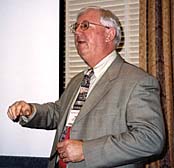
"I would say that 85 to 90 percent of owners today used to be technicians themselves," said Grandy, the owner of Grandy & Associates, Owensboro, Ky. The lack of business training can be a disadvantage but not necessarily a deterrent.
"The first question to ask is, ‘How much do I charge for my work?'" Grandy said. "You could call around and find out what everyone else is charging and use that price, or maybe a little less.
"But at a certain point in time you find yourself working harder and harder and making less money. This gradual process takes place in the first one to four years in business."
Grandy said there are three steps that new business owners usually take when they find themselves making less money.
1. Work harder and longer, producing more cash flow.
2. Use money from personal savings account and put it back into the company.
3. Remortgage the home and ask for extended lines of credit.
"All steps buy more time, but they do not solve the problem," he stated.
There are some key ingredients to determining what to charge and still make a decent profit, and Grandy outlined some of them at the HRAI convention.
Replacement Costs
Grandy said that it is important for contractors to have money available to replace equipment as it wears out, yet business owners often fail to understand how to calculate the replacement expense."This is typically the second highest cost of doing business," he remarked. "It catches up to you over time if you keep putting it off and fail to put aside money for replacements."
He used an example of how to calculate the cost of replacing one vehicle. A new truck purchased in 1999 for $18,000 is estimated to last for three years. The cost of a new truck three years later is $21,000. The number of years to replace it is three. The annual equipment cost is $7,000 (3 years x $7,000 = $21,000).
"Eventually you want to put yourself into a cash position and not a loan position," Grandy stated.
Labor Costs
Grandy said it is important to understand the terms "field labor" and "nonbillable time." Field labor is defined as "employees who are actually doing the work and whose hours may be charged directly to the customer.""If you are an owner and you work in the field all of the time, you are field labor," Grandy stated.
Nonbillable time is "hours that the company pays field labor but cannot charge the customer directly (shop time, vacation pay, travel time, working on vehicles, etc.) Grandy said that nonbillable time is "not necessarily nonproductive time."
He also said that the average "model" employee has a minimum of one hour a day that is nonbillable and that when averaged out over a year, the model employee will have a total of 20.5 percent of nonbillable time, which includes vacation, holiday, and sick pay. "This would be the best case scenario," Grandy said. "Charging out half of a tech's time is not unusual; it's just not what you want."
Grandy said that estimating billable labor hours is very important, since labor hours are "typically the single highest cost of doing business."
He said there are two important considerations when calculating field labor rates.
1. The biggest error most companies make is overestimating the number of billable hours to the customer.
2. Be conservative and underestimate the field labor rate.
Overhead
Grandy defined overhead as the "cost of doing business" and broke it down into fixed and variable overhead. "Why is it important to know what your overhead costs are?" Grandy asked. "It is impossible to set an accurate hourly rate; and you can't negotiate a price unless you know your cost of doing business. Can you lower your prices and still cover costs?"Grandy said that estimating projected labor costs for an upcoming year will allow for some flexibility in pricing and negotiating.
"As soon as you have hit your budgeted [labor] hours for the year, you can be creative with your pricing," he said. "You have the flexibility to drop prices if you need to get a particular job."
One way to offset some of the higher overhead costs, such as labor, is by charging a significant markup on materials. "We should be averaging 100 percent markup, which is common in our industry. This will absorb some of the overhead costs," Grandy said.
Besides a gross profit on material, Grandy said that overhead can be absorbed by the gross profit on subcontracting and direct labor.
And speaking of markup, he said it is one of the most misunderstood terms in the industry - along with profits. "Markup is the amount the company chooses to add to the product or service to come up with a selling price," Grandy said. "Profit is expressed as a percent of the total cost to the customer."
He said the "normal" net profit range for HVACR contractors usually falls between 5 and 15 percent.
"It is absolutely essential that a company generate profit to fund its future growth," he said.
"Don't be afraid to charge what you need to charge. In most cases customers want quality work, doing what you say you will do and doing it when you say you will do it.
"All of these things have nothing to do with price."
Publication date: 11/17/2003

Report Abusive Comment